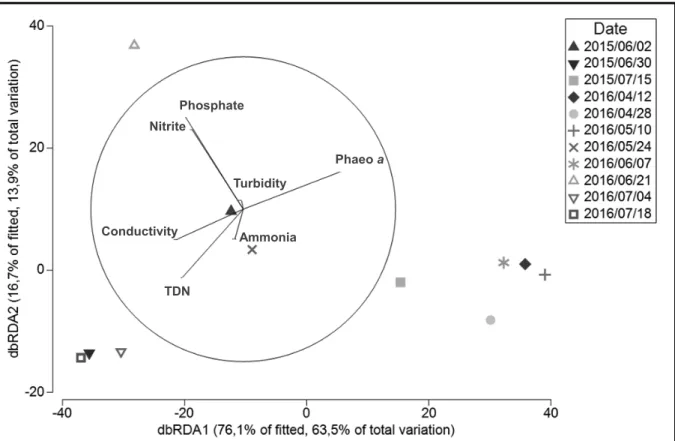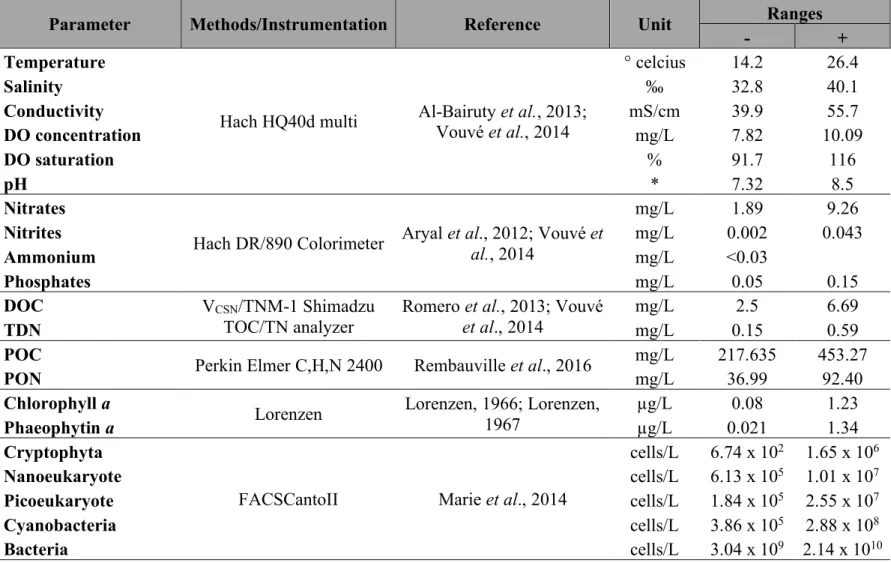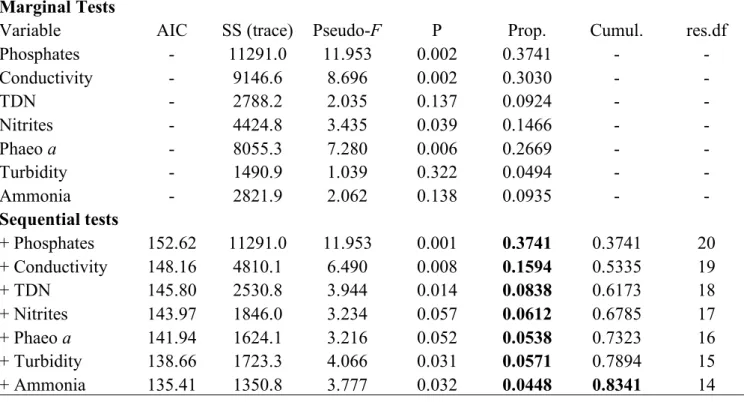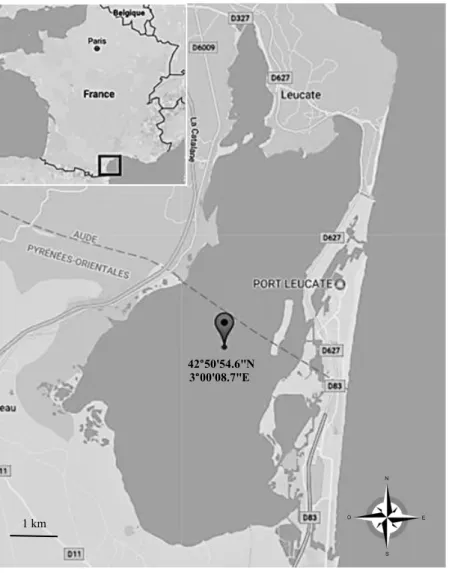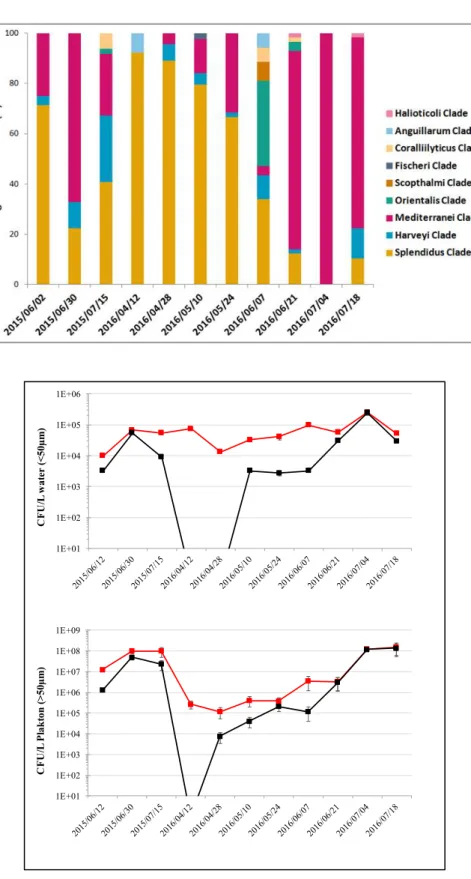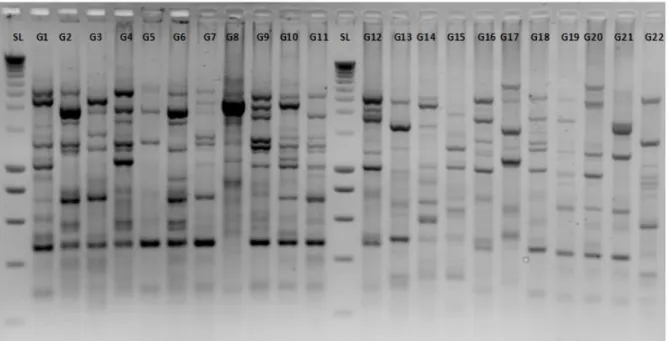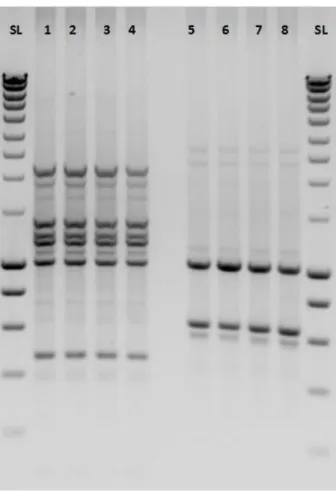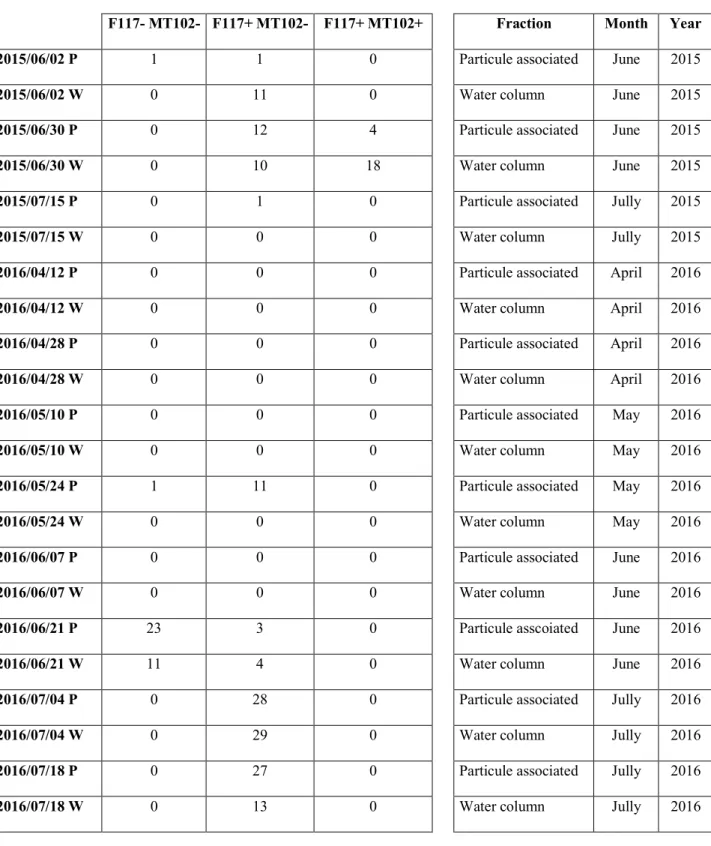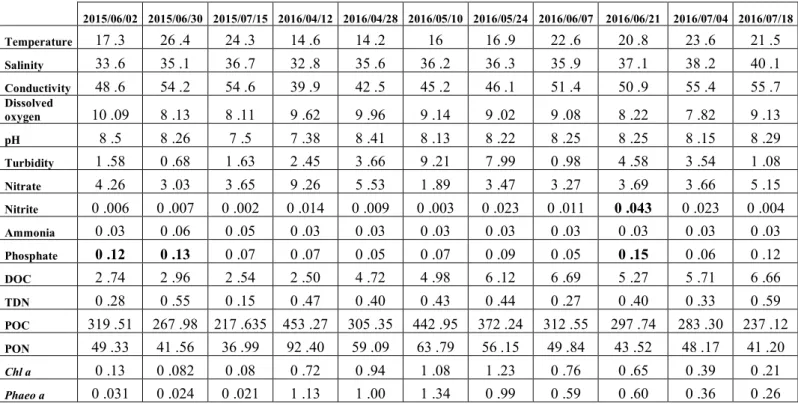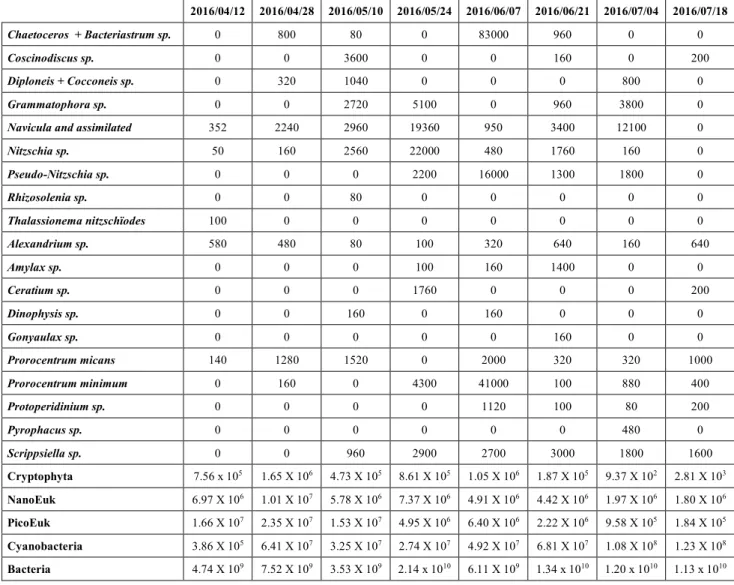HAL Id: hal-02909556
https://hal.sorbonne-universite.fr/hal-02909556
Submitted on 30 Jul 2020HAL is a multi-disciplinary open access
archive for the deposit and dissemination of sci-entific research documents, whether they are pub-lished or not. The documents may come from teaching and research institutions in France or abroad, or from public or private research centers.
L’archive ouverte pluridisciplinaire HAL, est destinée au dépôt et à la diffusion de documents scientifiques de niveau recherche, publiés ou non, émanant des établissements d’enseignement et de recherche français ou étrangers, des laboratoires publics ou privés.
Genetic diversity and phenotypic plasticity of
AHL-mediated Quorum sensing in environmental strains
of Vibrio mediterranei
Léa Girard, François Lantoine, Raphaël Lami, Florence Vouve, Marcelino
Suzuki, Julia Baudart
To cite this version:
Léa Girard, François Lantoine, Raphaël Lami, Florence Vouve, Marcelino Suzuki, et al.. Genetic di-versity and phenotypic plasticity of AHL-mediated Quorum sensing in environmental strains of Vibrio mediterranei. ISME Journal, Nature Publishing Group, 2019, 13 (1), pp.159-169. �10.1038/s41396-018-0260-4�. �hal-02909556�
Genetic Diversity and Phenotypic Plasticity of AHL Mediated Quorum
1Sensing in Environmental Strains of Vibrio mediterranei
2Léa Girard1, François Lantoine2, Raphael Lami1, Florence Vouvé3,1, Marcelino T. 3
Suzuki1 and Julia Baudart1* 4
5
1Sorbonne Université, CNRS, Laboratoire de Biodiversité et Biotechnologies Microbiennes 6
LBBM, F-66650 Banyuls sur Mer, France.
7
2Sorbonne Université, CNRS, Laboratoire d'Ecogéochimie des Environnements Benthiques, 8
LECOB, F-66650 Banyuls/Mer, France.
9
3Université Perpignan Via Domitia, Laboratoire Biocapteurs-Analyses-Environnement 10
(B.A.E), F-66860 Perpignan, France.
11
*Correspondance: J. Baudart, Sorbonne Université, CNRS, Laboratoire de Biodiversité et
12
Biotechnologies Microbiennes, LBBM, Observatoire Océanologique, F-66650 Banyuls/Mer,
13
France. E-mail :baudart@obs-banyuls.fr, Tel: +33468887368
14 15
Keywords: Quorum sensing, N-acyl-homoserine lactone, Vibrio mediterranei, Phenotypic
16
plasticity
17
Running title: Phenotypic Plasticity of AHL Mediated Quorum Sensing
18
Funding: This work was supported by a Ph.D. grant from doctoral school ED227 Sciences de
19
la Nature et de l'Homme : évolution et écologie associating Sorbonne Université and Museum
20
National d'Histoire Naturelle (MNHN), France.
21
Conflict of interest: The authors declare no conflict of interest.
22
To be submitted to ISME Journal - Subject Category Microbes-microbes and
microbe-23
host interactions
ABSTRACT
25
N-Acyl-Homoserine Lactone (AHL) mediated Quorum Sensing (QS) is one of the most
26
studied social behavior among Proteobacteria. However, despite the current knowledge on
27
QS-associated phenotypes such as bioluminescence, biofilm formation or pathogenesis, the
28
characterization of environmental factors driving QS in realistic ecological settings remains
29
scarce. We investigated the dynamic of AHL and AHL-producing Vibrio among 840 strains
30
isolated fortnightly from the Salses-Leucate Mediterranean lagoon in Spring and Summer
31
2015 and 2016. Vibrio isolates were identified by gyrB gene and genome sequencing and
32
AHL production was investigated by a biosensors-based UHPLC-HRMS/MS approach. Our
33
results revealed, for the first time, a succession of V. mediterranei isolates with different
34
AHL-production phenotypes over time and this dynamic lies with a single genotype (Average
35
genomic Nucleotide Identity (ANI) > 99.9). A multivariate DistLM analysis revealed that the
36
temporal variation of V. mediterranei QS phenotypes was explained by environmental
37
variables at 83.4%. Overall, our results suggest that isolates of a single genotype are able to
38
change their QS phenotypes in response to environmental conditions, highlighting phenotypic
39
plasticity of bacterial communication in the environment.
40
INTRODUCTION
42
Bacterial communities inhabiting marine coastal areas are subjected to rapid and somewhat
43
unpredictable changes in their environment (Lennon and Jones, 2011). In order to cope with
44
these changes, bacteria implement flexible strategies supporting a certain degree of
45
phenotypic plasticity (Agrawal, 2001; West-Eberhard, 2003; Chevin et al., 2010). Vibrio are
46
well-known for their capacity of rapid physiological adaptation in response to changing
47
environmental conditions, making them highly dynamic over short-term and seasonal scales
48
(Takemura et al., 2014). These opportunistic bacteria are sensitive to unfavorable conditions
49
by switching from an active free living state into a “dormant” viable but not culturable
50
(VBNC) phenotype, or by colonizing viscous surfaces such as biofilms (Whitesides and
51
Oliver, 1997; Li et al., 2014; Chimetto Tonon et al., 2015; Vezzulli et al., 2015). When
52
favorable conditions reappear their high reactivity allow them to colonize new substrate and
53
to be part of the microbial community associated with zooplankton, phytoplankton, and
54
marine vertebrates and invertebrates (Heidelberg et al., 2002; Ben-Haim, 2003; Soto et al.,
55
2009; Wendling and Wegner, 2015).
56
In the past decades, our vision of bacterial communities has significantly changed and
57
microbial cells are no longer considered to behave individually but rather to act socially (West
58
et al., 2006, 2007; Goo et al., 2015). It is now clear that microorganisms perform social
59
behaviors, synchronizing the expression of functional genes at high cell-density by sensing
60
their surrounding environment. This mechanism is generally known as Quorum sensing (QS)
61
(Fuqua et al., 1994) and Type 1 auto-inducers (AI-1) also called N-acyl-homoserine lactones
62
(AHL) are important signal molecules for the communication between close relative members
63
of Proteobacteria. Among Vibrio species, most of the studies are highlighting the processes
64
controlled by QS, i.e. QS-associated phenotypes, such as bioluminescence and symbiosis
2003), toxin production or expression of virulence factors (Zhu et al., 2002; Natrah et al.,
67
2011; Ha et al., 2014). In vitro studies have demonstrated the involvement of QS in the
68
“resuscitation” of viable but non-culturable (VBNC) Vibrio cells (Bari et al., 2013;
69
Ayrapetyan et al., 2014). However, Platt and Fuqua (2010) presented the QS process itself
70
(i.e. the production of signal molecules), as impacted by multiple aspects of natural
71
environments, and in support to this idea, some studies on AHL biosynthetic pathways have
72
suggested that any environmental factor likely to affect the primary metabolism of bacteria
73
can modify his spoken "language" (Hoang et al., 2002; Gould et al., 2006). Finally, several
74
studies have reported heterogeneous AHL Production Phenotypes (APP) among different
75
isolates of a single Vibrio species, i.e. the production of different sets of AHLs, according to
76
their origin (Buchholtz et al., 2006; García-Aljaro et al., 2012; Purohit et al., 2013;
77
Rasmussen et al., 2014).
78
Despite all this previous knowledge, the question of whether AHL Production Phenotypes
79
(APP) form coherent populations in the environment, show temporal dynamics, or respond to
80
different environmental conditions, remains largely underexplored. Therefore, in the present
81
study we investigated over a two-year period, the temporal dynamics of AHL-producing
82
Vibrio isolates from a French Mediterranean lagoon and evaluated the possible links between
83
phenotypic plasticity of AHL production and environmental conditions.
84
85
MATERIALS & METHODS
86
Sample collection
87
A two-years study was carried out during Spring and Summer (April to July) 2015 and
88
2016, at one sampling site in the South basin of the Salses-Leucate lagoon, on the
collected in sterile bottles and pre-filtered through a 50 µm mesh. Plankton was collected
91
using a 5 min horizontal tow at 2 knots of a 50 µm plankton net (30 cm diameter, 1 m length,
92
500 mL cod-end), and all samples were processed within three hours. For each sampling date,
93
triplicate plankton aliquots of 15 mL were fixed with 4% neutral Lugol’s solution (0.68 %
94
potassium iodide and 0.34 % iodine in distilled water) and stored in the dark at 4°C.
95
Taxonomic identification and enumeration were performed within two months. Surface
96
temperature (°C), salinity (psu), dissolved oxygen (DO, % saturation), conductivity (mS/cm)
97
and pH were recorded at each sampling date using a HQ40d multiparametric profiler (Hach).
98
Physico-chemical parameters, as well as pigments were analyzed using standard methods (the
99
methodological details can be found in Table 1).
100
Large phytoplankton and picoplankton counts
101
Phytoplankton counts were carried out with an Olympus IMT inverted microscope in
102
5, 10, 25 or 50 ml plate chambers using the Utermöhl method updated by Karlson and
103
collaborators (Karlson et al., 2010). Replicates of different volumes were counted according
104
to the size and the abundance of the cells. Small sized species were mainly counted in
105
diagonal transects at 300x magnification and for the large or less abundant species half or
106
whole chambers were scanned at 100x and 40x magnification. A minimum of one hundred
107
total cells were counted for each enumeration. Different settling times were applied according
108
to chamber volume in a temperature-controlled room (Karlson et al., 2010). For picoplankton
109
enumeration, seawater samples were collected (1.5 ml in triplicate fixed on board with 1%
110
glutaraldehyde and then quickly frozen at -80°C). The picoplankton abundances, including
111
cyanobacteria (mainly represented by Synechococcus), pico- and nano-eukaryotes, and
112
cryptophytes were measured with a FACSCanto II (Becton Dickinson) flow cytometer. The
113
analyses were performed within one month after the sampling. Heterotrophic bacterial cells
Reference beads (Fluoresbrite YG Microspheres, calibration grade 1.00 µm and 10.00 µm,
116
PolySciences, Inc) were added to each sample before acquiring the data. Each planktonic
117
group was analysed according to Marie et al. (2014) with the Cell Quest Pro software (Becton
118
Dickinson), in logarithmic mode, to separate the populations based on their scattering and
119
fluorescence signals.
120
Vibrio isolation and characterization
121
For the enumeration of Vibrio, water samples (0.1, 1, 10 mL) were filtered onto 0.45
122
µm pore-size nitrocellulose filters (Millipore, 47 mm), plated on the selective medium
123
thiosulfate-citrate–bile–sucrose (TCBS) (Pfeffer and Oliver, 2003) and incubated 24h at 20°C.
124
Vibrio strains were isolated from two fractions: less than 50 µm assumed to mostly represent
125
Vibrio in the water column and greater than 50 µm corresponding large phytoplankton and
126
zooplankton-associated Vibrio. The <50 µm fraction consisted of 20 L of 50 µm prefiltered
127
water further concentrated using a hollow fiber filter HF80S (Hemoflow, Fresenius Medical
128
Care). The concentrate was back-washed with 500 mL of a wash solution (0.01% sodium
129
hexametaphosphate, and 0.5% Tween 80; Sigma-Aldrich). The >50 µm fraction consisted of a
130
plankton net tow concentrate splited into five subsamples of 15 mL and homogenized by
131
gentle sonication for 5 min in order to unbind attached bacteria. For both fractions, a ten-fold
132
serial dilution was made in artificial seawater and 100 µL of each was plated in triplicate on
133
TCBS agar. Thirty colonies by fraction and by sampling date were randomly picked using a
134
gridded Petri dish.
135
Isolate identification
136
A total of 840 isolates were identified based on gyrB gene sequences. The PCR was
137
performed using colony cells and amplification reactions consisted of 12.5 µL of Kappa2G
138
Master Mix (KAPA2G Fast Hotstart ReadyMix PCR kit, KapaBiosystems), 6.25 µL of 10
mM MgCl2 and 1.25 µL of each of universal gyrB primers UPIE 140
(5'GAAGTCATCATGACCGTTCTGCAYGCNGGNGGNAARTTYRA 3') and UP2AR
141
(3'AGCAGGGTACGGATGTGCGAGCCRTCNACRTCNGCRTCNGYCAT 5') (Le Roux et
142
al., 2004). The PCR conditions were slightly optimized for the KAPA2G Fast DNA
143
Polymerase and were as following: a 5 min initial denaturation step at 95 °C, followed by 40
144
cycles at 95 °C for 15 sec, 60 °C for 30 s and 72 °C for 30 s, and a final elongation step of 2
145
min at 72 °C. PCR products were sent to Macrogen Europe for sequencing using the
dideoxy-146
termination (Sanger) reaction with the primer gyrB UP1S
(5'GAAGTCATCATGACC-147
GTTCTGCA3') (Yamamoto and Harayama, 1995) to obtain sequences around 800 bp length.
148
Detection of QS-active isolates
149
The methodological approach for the screening of AHL producers and the
150
identification of AHL compounds by Ultra High Performance Liquid Chromatography
151
coupled with High Resolution tandem Mass spectrometry UHPLC-HRMS/MS were strictly
152
identical to those previously described in Girard et al., (2017). Briefly, two biosensors were
153
used, Pseudomonas putida (pKR-C12) for long acyl-side chained AHLs (C8-C18) and
154
Escherichia coli (pJBA-132) for short acyl-side chained AHLs (C6-C10) (Girard et al., 2017).
155
Isolates were tested, in triplicate, on each biosensor immediately after isolation from the
156
environmental samples and also before mass spectrometry analysis.
157
Genetic and genomic characterization of V. mediterranei isolates
158
The genetic diversity of V. mediterranei isolates was evaluated by ERIC-PCR (Rivera
159
et al., 1995). Briefly, genomic DNA from 253 isolates was obtained by cellular lysis (3 quick
160
cycles of liquid nitrogen freeze/70°C thaw) and DNA concentrations were measured
161
spectrophotometrically in order to dilute each lysate at 100 ng/µL. The ERIC-PCR reactions
162
were performed using previously described protocols employing the ERIC1 and ERIC2
primers (Hulton et al., 1991; Khan et al., 2002). PCR amplifications were performed with the
164
GoTaq G2 Flexi polymerase (Promega) and fingerprinting profiles were visualized using a
165
Typhoon FLA 9000 imager (GE Life Sciences). Gel images analysis were performed using
166
the GelJ software (Heras et al., 2015). For whole genome sequencing, genomic DNA of two
167
V. mediterranei isolates (17 LN0615E and 21 LS0615E) was obtained with a classical
CTAB-168
β-mercaptoethanol extraction protocol and sent for DNA sequencing (Illumina MiSeq) by Mr
169
DNA (Shallowater, TX, USA) as described by Doberva et al., (2014). Genomes were
170
automatically annotated using the RAST server (Aziz et al., 2008).
171
Multivariate analyses
172
A preliminary PERMANOVA analysis (Anderson, 2001a) was used to test for
173
significant differences among Vibrio assemblages and V. mediterranei APP between the two
174
size fractions (<50µm and > 50µm). As the results indicated that there were no significant
175
differences between the two size fractions the remainder of the analysis was then performed
176
by pooling the counts from both fractions. The relationships between G1 V. mediterranei
177
assemblage (i.e. the abundance of each AHL production phenotypes over time, Square-root
178
transformed and Bray-Curtis distance matrix) and all measured environmental variables
179
(Normalization and Euclidean distance matrix) were investigated using a Distance Based
180
Linear Model (DISTLM) (McArdle and Anderson, 2001). In order to visualize if the temporal
181
variations of G1 phenotypes co-occurred with specific phytoplankton taxa, we conducted a
182
second step of analysis consisting of a Principal Component Ordination (PCO) of G1
183
phenotypes using phytoplankton counts (Square-root transformed and Bray-Curtis distance
184
matrix) as predictor variables (non-parametric Spearman rank correlation). All the
185
multivariate analyses were performed using PRIMER v.7 and its add-on package
186
PERMANOVA + (Anderson, 2001a; Anderson, 2001b; McArdle and Anderson, 2001).
RESULTS
188
Phenotypic and Genetic temporal variation of V. mediterranei isolates
189
The partitioning of Vibrio isolates, between the water column (<50 µm) and plankton
190
(>50 µm), was monitored during spring and summer 2015/2016 and a total of 840 isolates
191
were identified as Vibrio spp. We did not observe differences in Vibrio assemblages between
192
the fractions over time (data not shown, PERMANOVA, p value = 0.904; the temporal
193
variation of the total Vibrio spp. can be found in Fig S2). Isolates identification, based on gyrB
194
gene sequences, from both size fractions, showed a seasonal dynamic of V. mediterranei
195
isolates (Figure 1) in particular for 2016, starting from 0-28% of total Vibrio isolates during
196
spring and increasing gradually to up to 97% (Summer 2016). Interestingly, the phenotyping
197
of these isolates, under identical culture and screening conditions, revealed a temporal
198
variation of AHL production phenotypes (APPs) among time. APPs varied for example from
199
strains producing only long chain AHLs (F117+/MT102-) to those producing long and short 200
chain AHLs (F117+/MT102+) in 2015, or from a predominance of isolates exhibiting no 201
production (F117-/MT102-) to an exclusive production of long chain AHLs (F117+/MT102-) in 202
2016 (Figure 1B).
203
In order to determine if these phenotypic changes were related to a shift between
204
different genotypes of V. mediterranei, we used ERIC-PCR (Rivera et al., 1995) to genotype
205
253 V. mediterranei strains. A total of 22 genotypes were identified, G1 to G22 (i.e. Figure
206
1A and Supplementary Figure 3) and remarkably, 83% of the V. mediterranei isolates, over
207
the two years period, belonged to Genotype 1 (G1). To implement the genetic characterization
208
of V. mediterranei G1 isolates and to better understand the genetic basis of this phenotypic
209
variations, we obtained a draft whole genome sequence for two strains with different
210
phenotypes (17LN 0615E with F117+/MT102- phenotype and 21LN 0615E with
F117+/MT102+ phenotype, NCBI accession numbers NZ_NWTN00000000 and 212
NZ_NWTO00000000, respectively). A comparison between these genomes yielded an ANI
213
value of 99.96%. Since, as previously proposed, two strains can be considered identical if they
214
have a ANI value >99.9% (Snitkin et al., 2012; Olm et al., 2017), we consider that we
215
observed a phenotypic plasticity of AHL production within a single strain of V. mediterranei.
216
To summarize, we observed in 2016, the predominance of a single strain of V. mediterranei,
217
up to 97% of the total cultivable Vibrio spp., showing different APPs over time.
218
AHL characterization of G1 V. mediterranei APP
219
In order to confirm that the observed APPs indeed corresponded to different AHL
220
patterns, we analyzed the produced AHLs among two representative isolates of each
221
phenotype (F117+/MT102-) and (F117+/MT102+) by UHPLC-HRMS/MS. AHL
222
characterization was carried out according to the procedure described in Girard et al., 2017,
223
briefly, “anticipated” AHLs were identified by comparison with their corresponding standards
224
(Table S8) while “unanticipated” AHLs, without commercially available standards, were
225
identified based on their fragmentation patterns, predicted retention time and molecular weight
226
(i.e. Table S6 and S7). A total of 13 AHLs were detected and 8 were common to the four
227
isolates, namely OH-C10-HSL, oxo-C10-HSL, OH-C11-HSL, OH-C12-HSL, oxo-C12-HSL,
228
C12-HSL, C13-HSL and oxo-C13-HSL (Fig. 2 and Figure S4). Three short chain AHLs,
C6-229
HSL, oxo-C6-HSL, and oxo-C8-HSL were putatively identified as being responsible for the
230
F117+ /MT102+ phenotype. Interestingly, we observed that two long chain AHLs, oxo-C11-231
HSL and C14-HSL, were produced by the (F117+/MT102-) isolates but were not detected in 232
the (F117+/MT102+) isolates. Summarizing, the AHL analysis confirmed that the different 233
APPs detected by the biosensors are producing different AHLs patterns, with (F117+/MT102-) 234
producing long acyl-side chains and (F117+/MT102+) producing long plus short acyl-side 235
Genetic basis of AHL production
237
One possibility to explain these different APPs with highly similar genomes would be
238
that these differences were carried by different AHL synthase genes. Thus, we searched for
239
AHL synthase genes in the two genomes of V. mediterranei G1 strains and a LuxI/LuxR QS
240
system was found. However, as it has been shown that some Vibrio species can harbor two
241
AHL production pathways (LuxI/R and LuxM/N) we also searched for other putative
N-242
acetyltransferases in our two genomes. The comparison between the two strains (17 LN0615E
243
and 21 LS0615E) revealed a 100% protein identity for the AHL synthase LuxI (accession
244
numbers PRQ68803.1 and PCD89229.1, respectively) but also for the 15 putative
N-245
acetyltransferases (Table S9). Altogether these results suggest that the differences observed in
246
terms of AHL production patterns are not explained by different presumptive AHL synthases.
247
Factors affecting the dynamic of G1 - AHL production phenotypes
248
To investigate the relationships between the dynamic of the APPs among G1 strains
249
and the environmental variables we conducted a distance based linear modeling approach
250
(DistLM). A total of 7 variables explained 83.4% of the temporal variation of G1 APPs, and
251
among those, phosphates concentration was the variable with the highest explanatory value
252
(37.4 %) and ammonium concentration the lowest with 4.5% (Figure 3 and sequential tests,
253
Table 2). Axis 1 (db RDA1) represented essentially a gradient in abundance of the genotype
254
varying from high abundances at the left-end to low abundances or no counts at the right-end
255
(July 2015 and April/May 2016). Samples with high counts of V. mediterranei G1 were
256
associated with higher conductivity (an integrated measure of higher temperature and salinity),
257
total dissolved nitrogen, and low phaeophytin concentrations, while an inverted trend was
258
observed for samples with low counts or where V. mediterranei G1 was not retrieved. Axis 2
259
(db RDA2) reflected the distribution of the different APPs. A peak of phosphates and nitrites
were associated with an increase of non AHL producers in the higher end of the axis. As the
261
(F117+/MT102-) phenotype was dominant at dates with high counts of G1 isolates, the same 262
parameters are linked to counts of the (F117+/MT102-) phenotype at the lower end of db 263
RDA2 axis.
264
A principal coordinates analysis (PCO) was performed in order to visualize which
265
phytoplankton species co-occurred with the different APP (Fig 4). As observed in the db
266
RDA1, Axis 1 (PCO1) reflected the gradient in G1 abundances among the sampling dates with
267
the lowest counts of G1 in the right-end (July 2015 and April/May 2016) and where
268
picoeukaryotes, Cryptophyta, unidentified nanoeukaryotes, Dinophysis sp. and Prorocentrum
269
micans were present in their highest abundances. In the left-end of PCO axis 1 were samples
270
with the highest G1 counts (June 2015 and June/July 2016) associated to the highest counts of
271
Grammatophora sp. and Scrippsiella sp. and bacteria abundances. Axis 2 (PCO2) mostly
272
separates dates based on the presence of V mediterranei G1 AHL producers and
non-273
producers. While Gonyaulax sp., Amylax sp., seemed to be associated to dates with the highest
274
counts of non-producers (2016/06/21), Cyanobacteria and Pyrophacus sp. abundances were
275
linked to AHL producers.
276
Discussion
277It is well known that the ability of Vibrio, as well of other gram negative bacteria, to
278
survive by making biofilms, to infect hosts, to modify their metabolism or to enter into a
279
VBNC state, is modulated by QS (Ayrapetyan et al., 2014; Bondí et al., 2014; Goo et al.,
280
2015; Persat et al., 2015). In addition to the fact that QS allows bacteria to sense their number
281
and coordinate their actions, the variability of auto-inducers production might offer an
282
advantageous response to adapt their actions according to environmental fluctuations.
In order to survive in changing environment, bacteria have evolved to set up various
284
adaptive responses. Phenotypic plasticity is one of them and it reflects the direct influence of
285
the environment on the development of individual phenotypes, in other words, bacteria can
286
adapt to environmental selective pressures to maintain their own fitness. Phenotypic diversity
287
of QS systems has already been described for different strains of a single Vibrio species
288
(Buchholtz et al., 2006; Joelsson et al., 2006; García-Aljaro et al., 2012; Purohit et al., 2013)
289
and temporal changes in AHLs production during the development of natural biofilm
290
including Vibrio species as been shown (Huang et al., 2009). However, the scope of these
291
earlier studies did not show clear evidence of QS phenotypic plasticity. Our results show a
292
clear short-term temporal variation in APPs among environmental isolates of a single Vibrio
293
species (V. mediterranei) that were remarkably grouped in a single genotype (G1) based on
294
gyrB sequences, ERIC-PCR and genomic analysis. This change of AHL production patterns,
295
was temporally coherent and in some cases reached the near totality of Vibrio isolates in a
296
sample. As the ANI value among the two sequenced genomes was very high (99.96%) but not
297
identical, it is always possible that the residual 0.04% would be responsible for the differences
298
of APPs by some unknown mechanism. Nonetheless, the luxI sequences, coding for the AHL
299
synthase, as well as other putative N- acetyltransferases sequences are identical.
300
While it appears that we have different APPs belonging to a single genotype, the
301
temporal sampling of Vibrio isolates in parallel to physicochemical parameters measurements
302
allowed us to evaluate the variation in the “environment” leading to the phenotypic plasticity
303
of AHL production. However, as the sampling was originally designed to evaluate the
304
diversity of total Vibrio spp. (and not just that of V. mediterranei G1) the total numbers of
305
evaluated strains are limited, and thus in the following discussion we point to major trends and
306
propose ideas to be tested by more targeted studies.
Based on our DistLM analysis, phosphates concentration appeared as the most
308
explanatory variable by being correlated with high abundances of non AHL producers. That
309
was particularly striking on 21 June 2016, where the near totality of the strains belonged to the
310
(F117-/MT102-) phenotype which coincided with a peak of phosphates likely associated with 311
sediment resuspension. In order to explain this potential link between non-AHL producers and
312
high phosphates concentrations, we propose a possible implication of the polyphosphate
313
kinase activity. The whole genome analysis of the G1 isolates revealed few copies of the ppk
314
gene and several studies have demonstrated that polyphosphate kinase (ppk) enhance the
315
ability of bacteria to survive under environmental stresses. Since this enzyme has a negative
316
impact on AHLs production in P. fluorescens and is repressed at high phosphates
317
concentrations (Rashid et al., 2000; Jahid et al., 2006; Silby et al., 2009), it is tempting to link
318
the lack of AHL production to a repression of ppk by phosphates. As the peak of non AHL
319
producers, the 2016/06/21, occurred at the highest phosphates concentration in the two years
320
sampling, we hypothesized that in this context there is low expression of ppk gene and down
321
regulation of AHL production (Rashid et al., 2000).
322
The Salses-Leucate lagoon was also characterized by high Cyanobacteria
323
concentrations, mainly Synechococcus species, ranging between 3.86 x 105 to 2.88 x 108 324
cells/L, making them an important part of the microbial community. Over the study,
325
Cyanobacteria counts were highly correlated to the (FF17+/MT102+) phenotype abundances 326
(Pearson correlation 77.3%; p value = 0.002; June/July 2015) but also to the peak of the
327
(F117+/MT102-) phenotype (July 2016, Figure 4). In the past, Vibrio species have been 328
associated to cyanobacterial blooms (Berg et al., 2009), especially by benefiting from their
329
derived organic matter (Eiler et al., 2007). Mutual interactions were described between
330
Synechococcus species and heterotrophic bacteria (Hayashi et al., 2011), and co-culture
331
experiments between Vibrio species and Synechococcus revealed a deleterious effect on the
cyanobacteria physiology especially on iron, phosphates and nitrogen pathways (Tai et al.,
333
2009). In the other hand, since Synechococcus species harbors “orphan” luxR genes, possibly
334
encoding for the receptor LuxR involved in AHL signal reception, and shows quorum
335
quenching activity against Vibrio species, complex QS-based relationships might occur
336
between these two genera (Yoshino et al., 2013; Honda et al., 2014; Marsan et al., 2014;
337
Santhakumari et al., 2016; Shimura et al., 2017). Thereby, the temporal dynamic of different
338
APPs can be related to changes in the cyanobacterial assemblages, switching between
339
commensal/consumers, probably benefitting from cyanobacterial dissolved organic matter and
340
competitors for inorganic nutrient such as phosphates, nitrogen and iron. Understanding the in
341
situ interactions between APPs of V. mediterranei and cyanobacterial assemblages remains an
342
interesting subject for future studies.
343
Overall, our results indicate a phenotypic plasticity of AHL production among isolates
344
of a single genotype and converges towards the fact that our strains are harboring a single
345
AHL synthase gene (luxI). The underlying physiological mechanisms leading to this
346
phenotypic plasticity still yet to describe. However, it is well known that AHL synthases are
347
catalyzing the reaction between S-adenosylmethionine (SAM) and acyl-ACPs to produce
348
AHLs (Keller and Surette, 2006) and that the available acyl-ACP pools in bacteria may be
349
susceptible to metabolic changes (Gould et al., 2005). Considering that it has been recognized
350
that AHL production can be altered though the modulation of the fatty acid metabolic
351
pathway and that the variation of APPs was explained at 83.4% by the environmental
352
variables, it seems likely that fluctuations in the environment can change the nature of the
353
produced AHLs (Hoang et al., 2002; Gould et al., 2006). However, the facts that 1) a near
354
totality of the isolates were non-AHL producers at a time point and AHL-producers in a
355
subsequent time point, and 2) that these phenotypes were observed after two rounds of
356
isolation on rich medium, raises the intriguing possibility that epigenetic regulation might be
at play. It is well-known that the regulation of phenotypic variation is not always linked to 358
changes in DNA sequence and can be epigenetic in nature (Smits et al., 2006) and
359
interestingly, Kurz et al. (2013) have shown that epigenetic mechanisms can be involved in
360
the regulation of AHL-based QS system. We hypothesize that V. mediterranei strains could
361
keep a memory of the social traits expressed in the environment. However, as any previous
362
work have been published on the QS mechanisms of V. mediterranei, a consequent work on
363
the description of the QS pathways and QS associated phenotypes still need to be achieved to
364
confirm or deny this possible epigenetic control. Regardless of the mechanisms leading to the
365
observed phenotypic variation, phenotypic plasticity should confer an increased fitness as
366
heterogeneous populations should be better to adapt to rapid changes in the environment
367
(Feinberg et al., 2010). The fact that the studied phenotypically plastic V. mediterranei
368
populations thrive in a shallow lagoon subject to a relatively fast variation in physical and
369
biogeochemical conditions supports this idea. Understanding the possible mechanisms of
370
regulation of AHL-based QS in V. mediterranei remains a fascinating avenue for further
371
studies.
372
Finally, our work highlight the phenotypic plasticity of AHL production among
373
environmental Vibrio isolates. These results were obtained on strains after isolation and culture
374
on rich media which underlines the fact that Vibrio isolates could retain a memory of in situ
375
AHL production status. Considering the fact that quantification of AHL synthases expression
376
by RTqPCR is still difficult due to a very low sequence homology among vibrios (Tait et al.,
377
2010), the study of AHL-meditated QS by a biosensors based approach seems an interesting
378
alternative to estimate whether or not AHL synthesis occurred in the environment.
379
380
Conclusion
381QS is a well-studied social trait among Vibrio species, however, despite the current
382
knowledge obtained by in vitro studies on few species, there is a lack of studies regarding QS
383
in complex ecological communities. Our study provides a first investigation on the seasonal
384
dynamic of AHL producing Vibrio in a changing coastal environment and open new
385
perspectives for outgoing studies regarding QS mechanisms in natural habitats and a possible
386
epigenetic regulation of QS phenotypic plasticity.
387
Acknowledgements
388We would like to thank Professor Marti Anderson for her support with all statistical
389
analyses using PRIMER 7. We are thankful to Christophe Canal for the sampling campaigns
390
at Leucate Lagoon, and for the physico-chemical analysis performed on water samples. We
391
also thanks Jocelyne Caparros for inorganic nutrient analysis and Nicole Batailler for her
392
technical assistance in some steps of the experimental work. Finally, we thank the Bio2Mar
393
platform for providing access to the analytical chemistry and molecular biology equipment.
394
We would like to thank Laurence Fonbonne from the "Syndicat RIVAGE" for her help and
395
for giving us the access to the lagoon. This work was supported by a Ph.D. grant from
396
doctoral school ED227 Sciences de la Nature et de l'Homme : évolution et écologie
397
associating Sorbonne Université and Museum National d'Histoire Naturelle (MNHN), France.
398
399
References
400Agrawal, A.A., 2001. Phenotypic plasticity in the interactions and evolution of species.
401
Science 294: 321–326.
Al-Bairuty, G.A., Shaw, B.J., Handy, R.D., Henry, T.B., 2013. Histopathological effects of
403
waterborne copper nanoparticles and copper sulphate on the organs of rainbow trout
404
(Oncorhynchus mykiss). Aquat. Toxicol. 126: 104–115.
405
Anderson, Marti J, 2001. Permutation tests for univariate or multivariate analysis of variance
406
and regression. Can. J. Fish. Aquat. Sci. 58: 626–639.
407
Anderson, Marti J., 2001. A new method for non-parametric multivariate analysis of variance:
408
non-parametric MANOVA for ecology. Austral Ecol. 26: 32–46.
409
Aryal, D.R., Geissen, V., Ponce-Mendoza, A., Ramos-Reyes, R.R., Becker, M., 2012. Water
410
quality under intensive banana production and extensive pastureland in tropical Mexico. J.
411
Plant Nutr. Soil Sci. 175: 553–559.
412
Ayrapetyan, M., Williams, T.C., Oliver, J.D., 2014. Interspecific Quorum sensing mediates
413
the resuscitation of viable but nonculturable vibrios. Appl. Environ. Microbiol. 80: 2478–
414
2483.
415
Aziz, R.K., Bartels, D., Best, A.A., DeJongh, M., Disz, T., Edwards, R.A., Formsma, K., et
416
al., 2008. The RAST Server: Rapid annotations using subsystems technology. BMC
417
Genomics 9: 75.
418
Bari, S.M.N., Roky, M.K., Mohiuddin, M., Kamruzzaman, M., Mekalanos, J.J., Faruque,
419
S.M., 2013. Quorum-sensing autoinducers resuscitate dormant Vibrio cholerae in
420
environmental water samples. Proc. Natl. Acad. Sci. 110: 9926–9931.
421
Bassler, B.L., Losick, R., 2006. Bacterially Speaking. Cell 125: 237–246.
Bassler, B.L., Wright, M., Silverman, M.R., 1994. Multiple signalling systems controlling
423
expression of luminescence in Vibrio harveyi: sequence and function of genes encoding a
424
second sensory pathway. Mol. Microbiol. 13: 273–286.
425
Ben-Haim, Y., 2003. Vibrio coralliilyticus sp. nov., a temperature-dependent pathogen of the
426
coral Pocillopora damicornis. Int. J. Syst. Evol. Microbiol. 53: 309–315.
427
Berg, K.A., Lyra, C., Sivonen, K., Paulin, L., Suomalainen, S., Tuomi, P., et al., 2009. High
428
diversity of cultivable heterotrophic bacteria in association with cyanobacterial water blooms.
429
ISME J. 3: 314–325.
430
Bondí, R., Messina, M., De Fino, I., Bragonzi, A., Rampioni, G., Leoni, L., 2014. Affecting
431
Pseudomonas aeruginosa phenotypic plasticity by Quorum sensing dysregulation hampers
432
pathogenicity in murine chronic lung infection. PLoS ONE 9: e112105.
433
Buchholtz, C., Nielsen, K.F., Milton, D.L., Larsen, J.L., Gram, L., 2006. Profiling of acylated
434
homoserine lactones of Vibrio anguillarum in vitro and in vivo: Influence of growth
435
conditions and serotype. Syst. Appl. Microbiol. 29: 433–445.
436
Caraux, G., Pinloche, S., 2005. PermutMatrix: a graphical environment to arrange gene
437
expression profiles in optimal linear order. Bioinformatics 21: 1280–1281.
438
Casadesus, J., Low, D., 2006. Epigenetic gene regulation in the bacterial world. Microbiol.
439
Mol. Biol. Rev. 70: 830–856.
440
Chevin, L.-M., Lande, R., Mace, G.M., 2010. Adaptation, plasticity, and extinction in a
441
changing environment: Towards a predictive theory. PLoS Biol. 8: e1000357.
Chimetto Tonon, L.A., Silva, B.S. de O., Moreira, A.P.B., Valle, C., Alves, N., Cavalcanti,
443
G., et al., 2015. Diversity and ecological structure of vibrios in benthic and pelagic habitats
444
along a latitudinal gradient in the Southwest Atlantic Ocean. PeerJ 3: e741.
445
Chong, G., Kimyon, Ö., Manefield, M., 2013. Quorum sensing signal synthesis may represent
446
a selective advantage independent of its role in regulation of bioluminescence in Vibrio
447
fischeri. PLoS ONE 8: e67443.
448
Doberva, M., Sanchez-Ferandin, S., Ferandin, Y., Intertaglia, L., Joux, F., Lebaron, P., et al.,
449
2014. Genome sequence of Maribius sp. strain MOLA 401, a marine Roseobacter with a
450
Quorum-sensing cell-dependent physiology. Genome Announc. 2: e00997-14-e00997-14.
451
Eiler, A., Gonzalez-Rey, C., Allen, S., Bertilsson, S., 2007. Growth response of Vibrio
452
cholerae and other Vibrio spp. to cyanobacterial dissolved organic matter and temperature in
453
brackish water: Cyanobacterial DOM, temperature and Vibrio growth. FEMS Microbiol. Ecol.
454
60: 411–418.
455
Feinberg, Andrew P., and Rafael A. Irizarry. "Stochastic epigenetic variation as a driving
456
force of development, evolutionary adaptation, and disease." Proceedings of the National
457
Academy of Sciences 107.suppl 1 (2010): 1757-1764.
458
Fuqua, W.C., Winans, S.C., Greenberg, E.P., 1994. Quorum sensing in bacteria: the
LuxR-459
LuxI family of cell density-responsive transcriptional regulators. J. Bacteriol. 176: 269–275.
460
García-Aljaro, C., Vargas-Cespedes, G.J., Blanch, A.R., 2012. Detection of acylated
461
homoserine lactones produced by Vibrio spp. and related species isolated from water and
462
aquatic organisms. J. Appl. Microbiol. 112: 383–389.
Girard, L., Blanchet, E., Intertaglia, L., Baudart, J., Stien, D., Suzuki, et al., 2017.
464
Characterization of N-acyl homoserine lactones in Vibrio tasmaniensis LGP32 by a
465
biosensor-based UHPLC-HRMS/MS Method. Sensors 17: 906.
466
Goo, E., An, J.H., Kang, Y., Hwang, I., 2015. Control of bacterial metabolism by quorum
467
sensing. Trends Microbiol. 23: 567–576.
468
Gould, T.A., Herman, J., Krank, J., Murphy, R.C., Churchill, M.E.A., 2006. Specificity of
469
acyl-homoserine lactone synthases examined by mass spectrometry. J. Bacteriol. 188: 773–
470
783.
471
Ha, C., Kim, S.-K., Lee, M.-N., Lee, J.-H., 2014. Quorum sensing-dependent metalloprotease
472
VvpE is important in the virulence of Vibrio vulnificus to invertebrates. Microb. Pathog. 71–
473
72: 8–14.
474
Hammer, B.K., Bassler, B.L., 2003. Quorum sensing controls biofilm formation in Vibrio
475
cholerae. Mol. Microbiol. 50: 101–104.
476
Hayashi, S., Itoh, K., Suyama, K., 2011. Growth of the cyanobacterium Synechococcus
477
leopoliensis CCAP1405/1 on agar media in the presence of heterotrophic bacteria. Microbes
478
Environ. 26: 120–127.
479
Heidelberg, J.F., Heidelberg, K.B., Colwell, R.R., 2002. Bacteria of the γ-subclass
480
proteobacteria associated with zooplankton in Chesapeake bay. Appl. Environ. Microbiol. 68:
481
5498–5507.
482
Heras, J., Domínguez, C., Mata, E., Pascual, V., Lozano, C., Torres, C., et al., 2015. GelJ – a
483
tool for analyzing DNA fingerprint gel images. BMC Bioinformatics 16.
Hoang, T.T., Sullivan, S.A., Cusick, J.K., Schweizer, H.P., 2002. Beta-ketoacyl acyl carrier
485
protein reductase (FabG) activity of the fatty acid biosynthetic pathway is a determining
486
factor of 3-oxo-homoserine lactone acyl chain lengths. Microbiol. Read. Engl. 148: 3849–
487
3856.
488
Honda, T., Liang, Y., Arai, D., Ito, Y., Yoshino, T., Tanaka, T., 2014. Draft genome sequence
489
of marine cyanobacterium Synechococcus sp. strain NKBG042902, which harbors a
490
homogeneous plasmid available for metabolic engineering. Genome Announc. 2:
e00704-14-491
e00704-14.
492
Huang, Y.-L., Ki, J.-S., Lee, O.O., Qian, P.-Y., 2009. Evidence for the dynamics of acyl
493
homoserine lactone and AHL-producing bacteria during subtidal biofilm formation. ISME J.
494
3: 296–304.
495
Hulton, C.S., Higgins, C.F., Sharp, P.M., 1991. ERIC sequences: a novel family of repetitive
496
elements in the genomes of Escherichia coli, Salmonella typhimurium and other
497
enterobacteria. Mol. Microbiol. 5: 825–834.
498
Jahid, I.K., Silva, A.J., Benitez, J.A., 2006. Polyphosphate stores enhance the ability of Vibrio
499
cholerae to overcome environmental stresses in a low-phosphate environment. Appl. Environ.
500
Microbiol. 72: 7043–7049.
501
Joelsson, A., Liu, Z., Zhu, J., 2006. Genetic and phenotypic diversity of Quorum-sensing
502
systems in clinical and environmental isolates of Vibrio cholerae. Infect. Immun. 74: 1141–
503
1147.
504
Karlson, B., Cusack, C., Bresnan, E., 2010. Microscopic and molecular methods for
505
quantitative phytoplankton analysis.
Keller, L., Surette, M.G., 2006. Communication in bacteria: an ecological and evolutionary
507
perspective. Nat. Rev. Microbiol. 4: 249–258.
508
Khan, A.A., McCarthy, S., Wang, R.-F., Cerniglia, C.E., 2002. Characterization of United
509
States outbreak isolates of Vibrio parahaemolyticus using enterobacterial repetitive intergenic
510
consensus (ERIC) PCR and development of a rapid PCR method for detection of O3: K6
511
isolates. FEMS Microbiol. Lett. 206: 209–214.
512
Kurz, V., Nelson, E.M., Perry, N., Timp, W., Timp, G., 2013. Epigenetic memory emerging
513
from integrated transcription bursts. Biophys. J. 105: 1526–1532.
514
Le Roux, F., Gay, M., Lambert, C., Nicolas, J.-L., Gouy, M., Berthe, F.C.J., 2004.
515
Phylogenetic study and identification of Vibrio splendidus-related strains based on gyrB gene
516
sequences. Dis. Aquat. Organ. 58: 143.
517
Lennon, J.T., Jones, S.E., 2011. Microbial seed banks: the ecological and evolutionary
518
implications of dormancy. Nat. Rev. Microbiol. 9: 119–130.
519
Li, L., Mendis, N., Trigui, H., Oliver, J.D., Faucher, S.P., 2014. The importance of the viable
520
but non-culturable state in human bacterial pathogens. Front. Microbiol. 5.
521
Lorenzen, C.J., 1967. Determination of cholophyll and pheo-pigments: spectrophotometric
522
equations. Limnol. Oceanogr. 12: 343–346.
523
Lorenzen, C.J., 1966. A method for the continuous measurement of in vivo chlorophyll
524
concentration. Deep Sea Res. Oceanogr. Abstr. 13: 223–227.
525
Marie, D., Rigaut-Jalabert, F., Vaulot, D., 2014. An improved protocol for flow cytometry
526
analysis of phytoplankton cultures and natural samples: An improved protocol for flow
527
cytometry analysis. Cytometry A 85: 962–968.
Marsan, D., Wommack, K.E., Ravel, J., Chen, F., 2014. Draft genome sequence of
529
Synechococcus sp. strain CB0101, isolated from the chesapeake bay estuary. Genome
530
Announc. 2: e01111-13-e01111-13.
531
McArdle, B.H., Anderson, M.J., 2001. Fitting multivariate models to community data: A
532
comment on distance-based redundancy analysis. Ecology 82: 290.
533
Natrah, F.M.I., Ruwandeepika, H.A.D., Pawar, S., Karunasagar, I., Sorgeloos, P., Bossier, P.,
534
et al., 2011. Regulation of virulence factors by quorum sensing in Vibrio harveyi. Vet.
535
Microbiol. 154: 124–129.
536
Olm, M.R., Brown, C.T., Brooks, B., Firek, B., Baker, R., Burstein, D., et al., 2017. Identical
537
bacterial populations colonize premature infant gut, skin, and oral microbiomes and exhibit
538
different in situ growth rates. Genome Res. gr.213256.116.
539
Persat, A., Nadell, C.D., Kim, M.K., Ingremeau, F., Siryaporn, A., Drescher, et al., 2015. The
540
mechanical world of bacteria. Cell 161: 988–997.
541
Pfeffer, C., Oliver, J.D., 2003. A comparison of thiosulphate-citrate-bile salts-sucrose (TCBS)
542
agar and thiosulphate-chloride-iodide (TCI) agar for the isolation of Vibrio species from
543
estuarine environments. Lett. Appl. Microbiol. 36: 150–151.
544
Platt, T.G., Fuqua, C., 2010. What’s in a name? The semantics of quorum sensing. Trends
545
Microbiol. 18: 383–387.
546
Purohit, A.A., Johansen, J.A., Hansen, H., Leiros, H.-K.S., Kashulin, A., Karlsen, et al., 2013.
547
Presence of acyl-homoserine lactones in 57 members of the Vibrionaceae family. J. Appl.
548
Microbiol. 115: 835–847.
Rashid, M.H., Rumbaugh, K., Passador, L., Davies, D.G., Hamood, A.N., Iglewski, B.H., et
550
al., 2000. Polyphosphate kinase is essential for biofilm development, quorum sensing, and
551
virulence of Pseudomonas aeruginosa. Proc. Natl. Acad. Sci. 97: 9636–9641.
552
Rasmussen, B., Nielsen, K., Machado, H., Melchiorsen, J., Gram, L., Sonnenschein, E., 2014.
553
Global and phylogenetic distribution of Quorum sensing signals, acyl homoserine lactones, in
554
the family of Vibrionaceae. Mar. Drugs 12: 5527–5546.
555
Rembauville, M., Blain, S., Caparros, J., Salter, I., 2016. Particulate matter stoichiometry
556
driven by microplankton community structure in summer in the Indian sector of the Southern
557
Ocean: Particulate matter stoichiometry. Limnol. Oceanogr. 61: 1301–1321.
558
Rivera, I.G., Chowdhury, M.A., Huq, A., Jacobs, D., Martins, M.T., Colwell, R.R., 1995.
559
Enterobacterial repetitive intergenic consensus sequences and the PCR to generate
560
fingerprints of genomic DNAs from Vibrio cholerae O1, O139, and non-O1 strains. Appl.
561
Environ. Microbiol. 61: 2898–2904.
562
Romero, E., Peters, F., Guadayol, Ò., 2013. The interplay between short-term, mild
563
physicochemical forcing and plankton dynamics in a coastal area. Limnol. Oceanogr. 58:
564
903–920.
565
Santhakumari, S., Kannappan, A., Pandian, S.K., Thajuddin, N., Rajendran, R.B., Ravi, A.V.,
566
2016. Inhibitory effect of marine cyanobacterial extract on biofilm formation and virulence
567
factor production of bacterial pathogens causing vibriosis in aquaculture. J. Appl. Phycol. 28:
568
313–324.
569
Schwartzman, J.A., Ruby, E.G., 2015. A conserved chemical dialog of mutualism: lessons
570
from squid and vibrio. Microbes Infect.
Shimura, Y., Hirose, Y., Misawa, N., Wakazuki, S., Fujisawa, T., Nakamura, et al., 2017.
572
Complete genome sequence of a coastal cyanobacterium, Synechococcus sp. strain NIES-970.
573
Genome Announc. 5: e00139-17.
574
Silby, M.W., Nicoll, J.S., Levy, S.B., 2009. Requirement of polyphosphate by Pseudomonas
575
fluorescens Pf0-1 for competitive fitness and heat tolerance in laboratory media and sterile
576
Soil. Appl. Environ. Microbiol. 75: 3872–3881.
577
Smits, W.K., Kuipers, O.P., Veening, J.-W., 2006. Phenotypic variation in bacteria: the role
578
of feedback regulation. Nat. Rev. Microbiol. 4: 259–271.
579
Snitkin, E.S., Zelazny, A.M., Thomas, P.J., Stock, F., NISC Comparative sequencing program
580
group, Henderson, D.K., Palmore, T.N., Segre, J.A., 2012. Tracking a hospital outbreak of
581
carbapenem-resistant Klebsiella pneumoniae with whole-genome sequencing. Sci. Transl.
582
Med. 4: 148ra116.
583
Soto, W., Gutierrez, J., Remmenga, M.D., Nishiguchi, M.K., 2009. Salinity and temperature
584
effects on physiological responses of Vibrio fischeri from diverse ecological niches. Microb.
585
Ecol. 57: 140–150.
586
Tai, V., Paulsen, I.T., Phillippy, K., Johnson, D.A., Palenik, B., 2009. Whole-genome
587
microarray analyses of Synechococcus - Vibrio interactions. Environ. Microbiol. 11: 2698–
588
2709.
589
Tait, K., Hutchison, Z., Thompson, F.L., Munn, C.B., 2010. Quorum sensing signal
590
production and inhibition by coral-associated vibrios. Environ. Microbiol. Rep. 2: 145–150.
591
Takemura, A.F., Chien, D.M., Polz, M.F., 2014. Associations and dynamics of Vibrionaceae
592
in the environment, from the genus to the population level. Front. Microbiol. 5.
Vezzulli, L., Pezzati, E., Stauder, M., Stagnaro, L., Venier, P., Pruzzo, C., 2015. Aquatic
594
ecology of the oyster pathogens Vibrio splendidus and Vibrio aestuarianus. Environ.
595
Microbiol. 17: 1065–1080.
596
Vouvé, F., Buscail, R., Aubert, D., Labadie, P., Chevreuil, M., Canal, et al., 2014.
Bages-597
Sigean and Canet-St Nazaire lagoons (France): physico-chemical characteristics and
598
contaminant concentrations (Cu, Cd, PCBs and PBDEs) as environmental quality of water
599
and sediment. Environ. Sci. Pollut. Res. 21: 3005–3020.
600
Wagner-Döbler, I., Thiel, V., Eberl, L., Allgaier, M., Bodor, A., Meyer, et al., 2005.
601
Discovery of complex mixtures of novel long-chain Quorum sensing signals in free-living and
602
host-associated marine Alphaproteobacteria. ChemBioChem 6: 2195–2206.
603
Watson, W.T., Minogue, T.D., Val, D.L., Von Bodman, S.B., Churchill, M.E.A., 2002.
604
Structural basis and specificity of acyl-homoserine lactone signal production in bacterial
605
Quorum sensing. Mol. Cell 9: 685–694.
606
Wendling, C.C., Wegner, K.M., 2015. Adaptation to enemy shifts: rapid resistance evolution
607
to local Vibrio spp. in invasive Pacific oysters. Proc. R. Soc. B Biol. Sci. 282: 20142244–
608
20142244.
609
West, S.A., Diggle, S.P., Buckling, A., Gardner, A., Griffin, A.S., 2007. The social lives of
610
microbes. Annu. Rev. Ecol. Evol. Syst. 38: 53–77.
611
West, S.A., Griffin, A.S., Gardner, A., Diggle, S.P., 2006. Social evolution theory for
612
microorganisms. Nat. Rev. Microbiol. 4: 597–607.
613
West-Eberhard, M.J., 2003. Developmental plasticity and evolution. Oxford University Press,
614
Oxford ; New York.
Whitesides, M.D., Oliver, J.D., 1997. Resuscitation of Vibrio vulnificus from the viable but
616
nonculturable state. Appl. Environ. Microbiol. 63: 1002–1005.
617
Yamamoto, S., Harayama, S., 1995. PCR amplification and direct sequencing of gyrB genes
618
with universal primers and their application to the detection and taxonomic analysis of
619
Pseudomonas putida strains. Appl. Environ. Microbiol. 61: 1104–1109.
620
Yoshino, T., Honda, T., Tanaka, M., Tanaka, T., 2013. Draft genome sequence of marine
621
cyanobacterium Synechococcus sp. Strain NKBG15041c. Genome Announc. 1:
e00954-13-622
e00954-13.
623
Zhu, J., Miller, M.B., Vance, R.E., Dziejman, M., Bassler, B.L., Mekalanos, J.J., 2002.
624
Quorum-sensing regulators control virulence gene expression in Vibrio cholerae. Proc. Natl.
625 Acad. Sci. 99: 3129–3134. 626 627 628 629 630 631 632 633
Figure 1 Temporal dynamic of V. mediterranei isolates relative to all Vibrio spp. isolates. A.
634
G1-G22 are Genotypes based on ERIC-PCR; B. APP: AHL Production Phenotypes; where
635
F117+ and F117- are isolates detectable or not by the biosensor Pseudomonas putida
(pKR-636
C12) and MT102+ and MT102- are detectable or not by the biosensor Escherichia coli
637
(pJBA-132).
638
Figure 2 Heat-Map of AHL diversity in V. mediterranei G1 isolates by UHPLC-HRMS/MS
639
(Ward's classification based on Jaccard index; Caraux and Pinloche, 2005). 1: 17LN0615E
640
and 2: 2LS0615E corresponding to the F117+/MT102+ phenotype; 3: 21LN0615E and 4: 641
9LS0615E corresponding to the F117+/MT102- phenotype. (*) unanticipated AHLs 642
corresponding to any analyzed AHL standards. Grey squares represent the absence of AHL.
643
Figure 3 The dbRDA ordination representing the results of the DistLM analysis in 2D. The
644
DistLM is used to examine the relationship between the distribution and temporal dynamics
645
of V. mediterranei G1 APP and all measured environmental variables. Vectors represent
646
predictor variables used for the construction of the constrained ordination (the dbRDA
647
diagram), and the length of the vectors represents the explanatory percentage of each variable.
648
The analysis is detailed Table 2.
649
Figure 4 Principal co-ordinate plot (PCO) of V. mediterranei G1 phenotypes for the first and
650
second principal co-ordinates using the Bray-Curtis similarity matrix. Phytoplankton and
651
Bacteria counts were used as predictor variables, are shown here only the variable with
652
Pearson correlation >0.45. The analysis is detailed in Supplementary Table 4 and the
653
contribution of each variable in the construction of PCO axis (Pearson correlation) is detailed
654
in Supplementary Table 5.
655 656
Figure 3. Phosphate Nitrite Turbidity Phaeo a Ammonia TDN Conductivity
Table 1 Environmental parameters measurements
Parameter Methods/Instrumentation Reference Unit Ranges
- +
Temperature
Hach HQ40d multi Al-Bairuty et al., 2013; Vouvé et al., 2014
° celcius 14.2 26.4 Salinity ‰ 32.8 40.1 Conductivity mS/cm 39.9 55.7 DO concentration mg/L 7.82 10.09 DO saturation % 91.7 116 pH * 7.32 8.5 Nitrates
Hach DR/890 Colorimeter Aryal et al., 2012; Vouvé et al., 2014
mg/L 1.89 9.26 Nitrites mg/L 0.002 0.043 Ammonium mg/L <0.03 Phosphates mg/L 0.05 0.15 DOC VCSN/TNM-1 Shimadzu TOC/TN analyzer
Romero et al., 2013; Vouvé et al., 2014
mg/L 2.5 6.69
TDN mg/L 0.15 0.59
POC
Perkin Elmer C,H,N 2400 Rembauville et al., 2016 mg/L 217.635 453.27
PON mg/L 36.99 92.40
Chlorophyll a Lorenzen Lorenzen, 1966; Lorenzen,
1967
µg/L 0.08 1.23
Phaeophytin a µg/L 0.021 1.34
Cryptophyta
FACSCantoII Marie et al., 2014
cells/L 6.74 x 102 1.65 x 106
Nanoeukaryote cells/L 6.13 x 105 1.01 x 107
Picoeukaryote cells/L 1.84 x 105 2.55 x 107
Cyanobacteria cells/L 3.86 x 105 2.88 x 108
Table 2: Test statistics for Distance-based Linear Model (DISTLM) analyses marginal and sequential tests based on ‘Forward’ procedure and AIC criteria of V. mediterranei G1 phenotypes abundance at the 11 sampling dates. Marginal tests show how much variation each variable explains when considered alone, ignoring other variables. Sequential tests explain the cumulative variation attributed to each variable fitted to the model in the order specified, taking previous variables into account.
Marginal Tests
Variable AIC SS (trace) Pseudo-F P Prop. Cumul. res.df
Phosphates - 11291.0 11.953 0.002 0.3741 - - Conductivity - 9146.6 8.696 0.002 0.3030 - - TDN - 2788.2 2.035 0.137 0.0924 - - Nitrites - 4424.8 3.435 0.039 0.1466 - - Phaeo a - 8055.3 7.280 0.006 0.2669 - - Turbidity - 1490.9 1.039 0.322 0.0494 - - Ammonia - 2821.9 2.062 0.138 0.0935 - - Sequential tests + Phosphates 152.62 11291.0 11.953 0.001 0.3741 0.3741 20 + Conductivity 148.16 4810.1 6.490 0.008 0.1594 0.5335 19 + TDN 145.80 2530.8 3.944 0.014 0.0838 0.6173 18 + Nitrites 143.97 1846.0 3.234 0.057 0.0612 0.6785 17 + Phaeo a 141.94 1624.1 3.216 0.052 0.0538 0.7323 16 + Turbidity 138.66 1723.3 4.066 0.031 0.0571 0.7894 15 + Ammonia 135.41 1350.8 3.777 0.032 0.0448 0.8341 14
SUPPLEMENTARY INFORMATION
Fig S1: Location of the sampling site within the Salses-Leucate Mediterranean lagoon.
42°50'54.6"N 3°00'08.7"E
Fig S2: Temporal dynamic of Vibrio spp. isolates. (A). Relative proportion of isolates related – clade
amongthe isolates identified as Vibrio spp. (B). Abundance in water and plankton of total culturable
Vibrio spp. (red line) and culturable V. mediterranei (back line)
1E+01 1E+02 1E+03 1E+04 1E+05 1E+06 C F U /L w at er ( < 50 µ m) 1E+01 1E+02 1E+03 1E+04 1E+05 1E+06 1E+07 1E+08 1E+09 C F U /L P lak ton ( > 50 µ m)
Fig S3: Agarose gel electrophoresis of V. mediterranei isolates using ERIC 1R and ERIC 2 primers.
